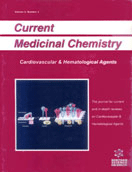Abstract
Bradykinin and Lys-bradykinin are potent peptide mediators implicated in several physiopathological effects in mammals. They act through activation of G-protein-coupled constitutive B2 or inducible kinin B1 receptors linked to signaling pathways involving increased intracellular Ca++ concentrations and / or release of mediators including arachidonic acid metabolites, NO and EDHF. In the cardiovascular system, the kallikrein-kinin system exerts a fine control of vascular smooth muscle tone and arterial blood pressure, and plays a significant cardioprotective effect. This has been lately confirmed in experimental studies employing transgenic mice overexpressing human tissue kallikrein and animals with knockout of kinin B1 and B2 receptor gene. Disturbances in this system are associated with arterial hypertension, myocardial ischaemia and other clinical complications. Inhibitors of kininase II (angiotensin-converting enzyme) have been prescribed successfully to patients with cardiovascular diseases, but there is still a great interest in developing drugs or pharmacological strategies that augment the activity of kininogen-kallikrein-kinin system in pathological conditions. Delivery of adenovirus vector containing the human tissue kallikrein gene (gene kallikrein therapy) has emerged as a great potential to satisfy these conditions. This review provides a summary of plasma and tissue kallikrein-kinin system, focusing on the pharmacological properties, kinin receptors and drugs reported to interfere with their actions. The modulatory effects of the kallikrein-kinin system on cardiovascular system, particularly in regulating smooth muscle tone and arterial blood pressure and in preventing myocardium ischaemia have also been explored in the review.
 34
34













